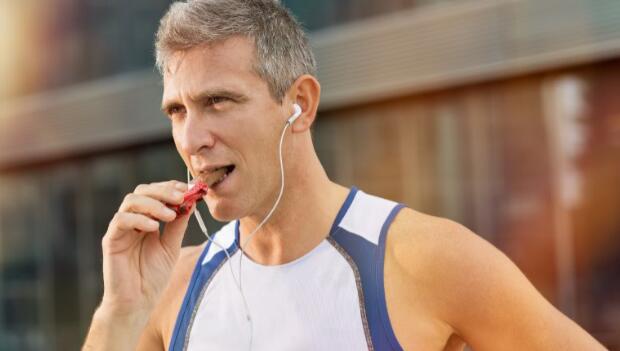
This case study is about one woman's quest to transform her nutrition as a means to drop body fat, improve energy levels and ultimately join the triathlon masses for her first half-Ironman (the California 70.3, which took place March 31).
Client Description: Eme, a 29-year-old triathlon newbie, first entered my office a bit perplexed as to why the heck she entered a 70.3-mile triathlon in only her second season in the sport.
Nevertheless, she was determined to not only conquer the challenge but to also improve her overall diet as a means to drop a few pounds of body fat and increase her energy levels. A family history of obesity and diabetes—and a subsequent fear of heading down the same road—was also a huge motivator for Eme to make the appropriate nutrition and fitness lifestyle changes.
Nutritional Obstacle No. 1: Curbing Her Intense Sweet Tooth
A self-proclaimed sugar-lover, Eme warned me of an inability to drop certain foods—namely chocolate—from her diet. But I assured her that all foods fit as long as portions are kept in check and a balanced menu is in place. Oftentimes, sugar cravings occur as a result of erratic eating habits, imbalanced meals and/or excessive calorie restriction during portions of the day.
More: 5 Little Things That Make a Big Difference on Race Day
Blood sugars rise and fall in two- to four-hour increments throughout the day; and when on the downward spiral, hormones are released that can intensify food cravings (especially sweets, which spike blood sugars quickly and cause a rebound drop).
Also, skipping meals or being light on calories during the initial stages of the day can set one up for a sugar binge in the afternoon/evening hours that can be dangerous for those with any form of insulin resistance or pre-diabetic state as it not only elevates risk for the onset of type 2 diabetes but also doubles the risk for heart disease.
Macronutrient favoring (eating too many carbohydrates and not enough protein or vise versa, for example) can also pose a problem. (Carbohydrates are needed to help boost blood sugars and protein is needed to help slow the release of the sugar into the bloodstream, thereby contributing to more sustained energy levels.)
Solution: To support her triathlon training and help mute sugar cravings, I prescribed Eme a 1,750-calorie baseline intake with a 250-calorie restriction to support her fat-loss goals. Eme's calories were equally distributed over four to six smaller meals containing 250 to 375 calories with additional portions/calories being added to compensate for her daily training expenditure.
More: Plan Nutrition to Avoid Race-Day Bonk
Her menu plan was created so that main meals contained a fistful of protein (such as nonfat yogurt, eggs, lean meats, fish or beans), a fistful of starch (such as sweet potatoes, corn, brown rice, whole-wheat pasta, and bread or oatmeal) and two fistfuls of color (fruits and non-starchy vegetables). Healthy fats, like nuts or seeds, avocado and olives, were also added to help curb her appetite.
This balance solicits a low-glycemic response, helping to maintain optimal blood sugar levels and mute sugar cravings. And, yes, even small amounts of chocolate were allowed. Eme reported an immediate improvement in energy levels and over a 12-week period dropped nearly eight pounds of body fat while maintaining lean body mass.
Nutritional Obstacle No. 2: Calorie Overcompensation After Heavy Workouts
Most of us agree that one of the perks of triathlon is the amazing social outlet it provides--especially that post-training meal at a local hotspot. But it is very easy to vastly underestimate calorie intake when being served large portions in restaurants as well as eating in a subconscious or social state. Furthermore, it doesn't help that a lot of calorie expenditure readings overestimate what we actually expend.
For example, according to a study published in Medical Science of Sports and Exercise, heart-rate monitors can overestimate actual calorie expenditure by as much as 12 percent and exercise machines are even worse; often reporting expenditures about 20 percent too great. Long story short: An understanding of calorie expenditure and appropriate food portions is essential for the athlete looking to drop body fat and optimize health and triathlon performance.
More: How to Reduce GI Distress on Race Day
Solution: Eme was guided on how to calculate her training expenditure to avoid a pattern of calorie overcompensation post-workout. For every mile of swimming, Eme burns approximately 350 calories. Based on her cycling speed, Eme burns an average of 400 to 500 calories per hour, whereas on the run she burns an average of 450 to 550 calories per hour of which she replaced 30 to 50 percent during training and on race day in the form of a sports drink.
Eme jump started her recovery nutrition with a pint of low-fat chocolate milk (about 300 to 400 calories), and then was instructed to fulfill any specific food cravings (the body is very efficient at indicating nutrients that have been depleted after undergoing physical stress).
Furthermore, I counseled Eme on her exact calorie deficit and introduced her to the Food Exchange system, which has helped her stay within recommended portions to avoid food overcompensation and unwanted fat gain during training. As a result, Eme not only conquered her first 70.3 triathlon but actually exceeded her finish-time expectations.
More: Swimming for Recovery
 Find your next triathlon.
Find your next triathlon.



